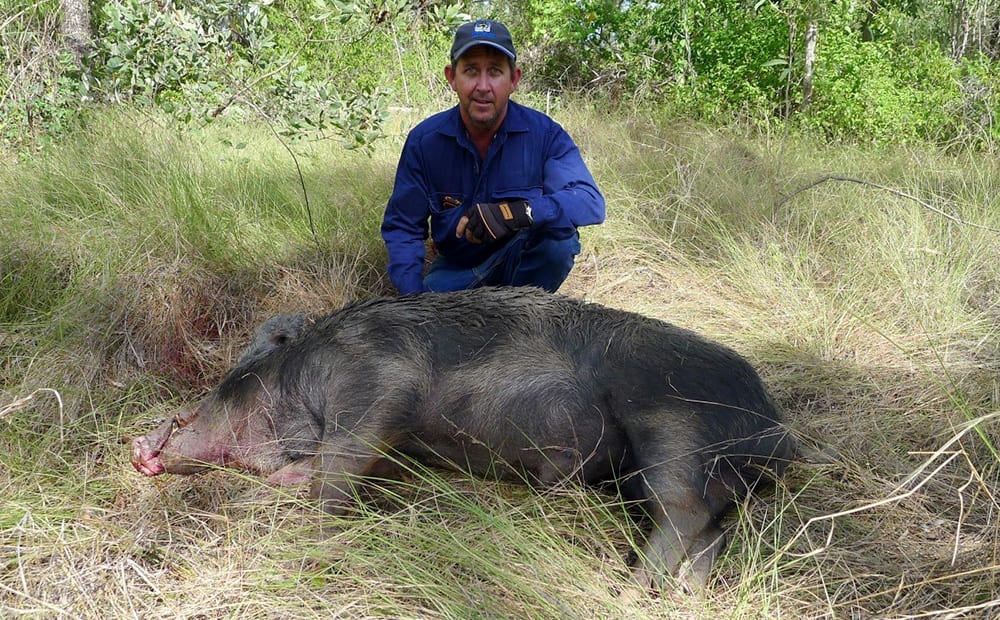Council’s feral pig control program is on track
The Whitsunday Regional Council’s 2018/19 feral pig aerial control program is on course to eclipse the previous year’s tally. The LDC project matches landholders’ contributions towards the cost of the aerial control in the Whitsunday region.
LDC will match every $200 landholder contribution to the Whitsunday Regional Council’s 2018/19 annual feral animal program.
The financial contribution fits in with the LDC project’s aims to tackle erosion and improve land management, productivity and water quality flowing into the Great Barrier Reef Lagoon.
Landholder contributions are tax deductible.
Feral pigs contribute to soil erosion and weed spread, consume and foul molasses, lick blocks, pasture and watering points, spread disease and can reduce calving rates.
Whitsunday Regional Council has identified feral animal ‘hot spots’ in the region which coincide with wetland areas, deep water creek areas and regular food sources.
Reef catchment councils work together to improve practices and support each other’s programs through the Reef Guardian Councils partnership with the Great Barrier Reef Marine Park Authority and the Reef Urban Stormwater Management Group.
Local government investment for outcomes for the reef is acknowledged in the Reef 2050 Water Quality Improvement Plan.
For more information, contact the Whitsunday Regional Council on 1300 972 753.
Bren Fuller with a feral pig
Contributed by WRC’s Scott Hardy and Bren Fuller
SNAPSHOT
2017-18 tally of feral pigs: 1280.
2018-19 (to October 2018) tally of feral pigs: 772.
Helicopter flights: six flights covering 1878 km.
Average cost to cull each pig: $48.
51 landholders contributed to the program.
The annual aerial shooting program will cost about $100,000 including $70,000 cash and $30,000 of in-kind support.
| Feral Animal Management Areas | Syndicate | Shoot date | Flight distance Km | Feral pigs culled | Wild dogs | Deer | Total culled | Cost per animal destroyed (helicopter time plus ammunition) |
| Birralee | ||||||||
| Birralee | Collinsville bridge to Bowen River mouth | 12.09.18 | 343.4 | 248 | 1 | No deer shot. Deer present along water courses | 249 | $27.45 |
| Bogie | Glenalpine to Strathalbyn | 17.09.18 | 474.6 | 117 | 4 | No deer observed | 121 | $51.97 |
| Rocky Ponds | Leichardt Creek, Rocky Ponds Creek to coast | 19.09.18 | 400.5 | 149 | 1 | No deer observed | 150 | $42.60 |
| Abbot Point | Eurie Creek to Elliot River | 28.09.18 | 317.2 | 117 | 2 | No deer observed | 119 | $51.56 |
| Goorganga | Goorganga to Andromache | 03.10.18 | 190.9 | 34 | 7 | No deer observed | 41 | $82.48 |
| Don River | Selina Creek to Reeves Road | 18.10.18 | 151.6 | 107 | 3 | No deer observed | 110 | $36.15 |
| Suttor River | Cantaur Park to Illamatha | TBC | ||||||
| Burdekin Dam | Burdekin Dam and Lower section of Burdekin shire | TBC | ||||||
| Totals | 1878.2 | 772 | 18 | 790 | $48.70 average |
Summary of the feral pig control program
Whitsunday Regional Council’s Bren Fuller said council’s feral pig aerial control program was rolling out smoothly thanks to the financial support of the region’s landholders and stakeholders groups.
This is his wrap-up:
Putting a chopper in the air is not cheap so the council relies on funds from the ratepayer, natural resource management groups and industry bodies to help cover the costs. If we all chip in, we all benefit.
The feedback from landholders who have taken part in the program has been positive.
Some landholders have said their calving numbers improved and others said the damage to their crops dropped, which they attributed to the aerial shooting program.
The council has structured the program to direct available funding where it’s needed most, in conjunction with good planning.
Locating feral pigs in the landscape relies on us mapping wetland, rivers and large dam areas, as well as talking to landholders who know their patch.
With this intelligence, we develop Feral Animal Management Areas (FAMAs) that show where there is food, water and shelter for the pigs.
From there, we make a list of the landholders in the FAMA which form our landholder syndicates.
During the past few years I have talked about this program to more than 200 landholders. I think council is starting to develop a really good project that has the support of a lot of graziers and also the horticulture industry.
We have started producing a newsletter to summarise the outcomes of the project. Landholders can quickly look across the landscape and wee where the pigs have been destroyed. We also include a map showing the helicopter flight paths.
There is nothing like doing a job where you can see that you you have made a positive difference on the ground, and getting feedback from landholders that they also notice a difference.
Regional Pest Management
Pest plants and animals threaten our region’s economic, social and environmental sustainability.
As a leading member of the Burdekin Dry Tropics Regional Pest Management Group (RPMG), NQ Dry Tropics works alongside partners including Biosecurity Queensland, Queensland Department of National Parks, local government, industry and landcare groups to determine the region’s priority pest plants and animals, and how best to manage them.
The RPMG has developed and implemented four long-term management plans for feral pigs, feral chital deer, siam weed and prickly acacia.
These plans target investment on high-value environmental, agricultural and culturally important areas.
NQ Dry Tropics is also an active member of the Sagittaria Working Group, an initiative of the RPMG, which promotes awareness of Sagittaria platyphylla among community members at regular events.
*Whitsunday Regional Council is a Burdekin Dry Tropics Regional Pest Management Group partner.

